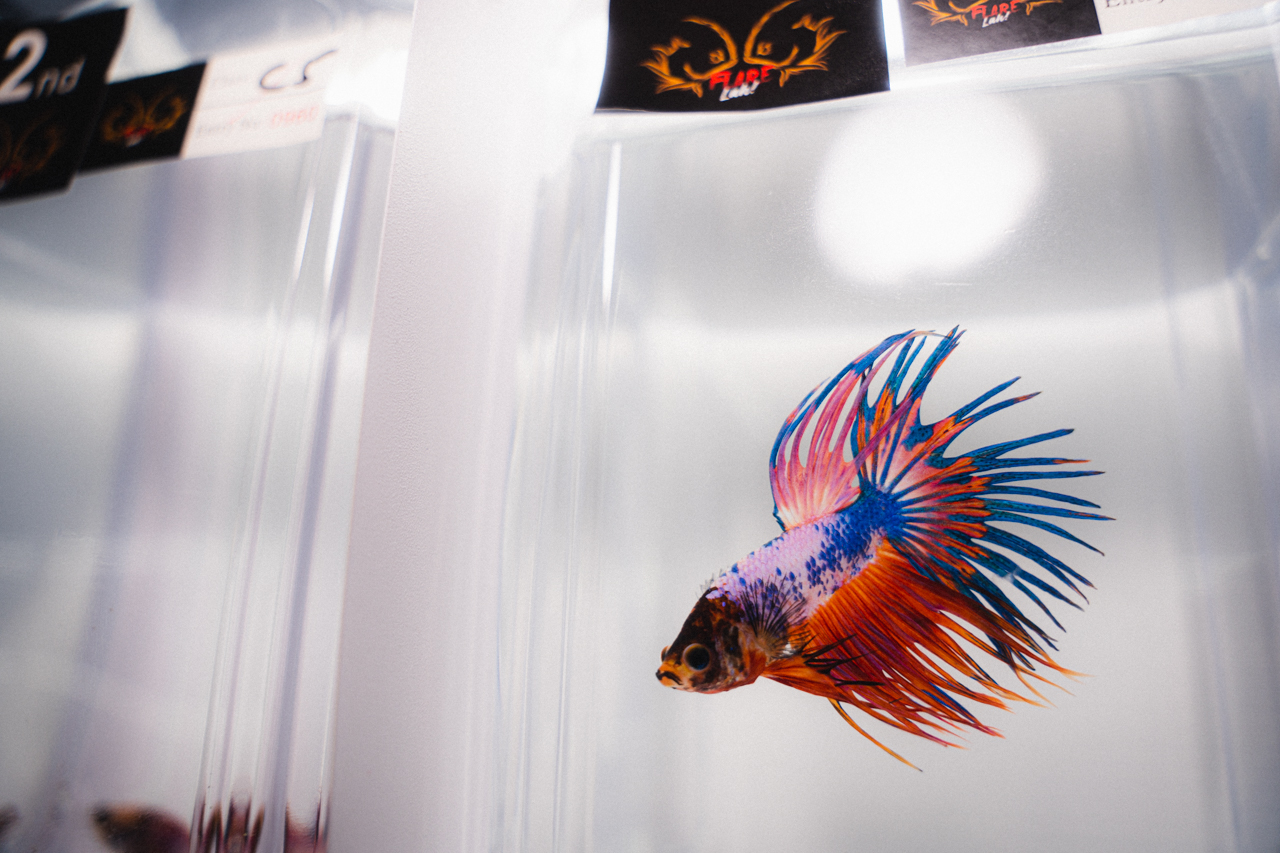All images by Zachary Tang for RICE Media, unless otherwise stated.
It’s just hitting golden hour on a Saturday evening when Darwin Quaristino greets me at Diamond Koi Farm at 5 Chencharu Link, just off Mandai Avenue. He is dressed in his uniform—a plain black polo tee with the Singapore flag on the top left. Underneath the flag is an emblem of two orange fishes locked in a face-off.
Darwin, a sales consultant in his early 30s, is one of the organisers of today’s FlareLah! Betta fish competition. It’s a beauty contest where Betta fish (typically referred to by others as fighting fish) are judged on a series of criteria to crown the fairest of them all. These competitions usually occur at least once a month, and hobbyists learn about them through Telegram and Facebook.
With about two decades of Betta fish-rearing experiences under his belt, to say that Darwin is knowledgeable about the behaviours of the fish would be a severe understatement. After all, he started wading into the world of Betta fish at the tender age of seven when he still lived in Indonesia.
According to him, the Halfmoon Plakat—a class of Betta fishes characteristic of their short fins and tails shaped like a half-moon—are more popular amongst hobbyists today because they require little maintenance.
“They might be popular, but they are also more expensive to keep than other bettas. An outstanding quality Multicolor betta can cost up to a thousand dollars—the highest I heard was about S$1,200.”
Bettas didn’t use to look this gorgeous. Back in the 1950s, wild bettas were a dull greyish-green hue with short fins and were available for anyone to catch in floodplains and canals. Betta fish ‘fighting’ competitions, where male Betta fish fight to their deaths for gambling, were also commonplace.
Fortunately, these ‘fights’ are no longer a thing in Singapore.
After generations of selective breeding and colour evolution, these fishes have now transformed into fabulous beauty contestants.
They’re a sight to behold as their fins flutter elegantly in the water. Fighting not for might but the title of most elegant in show.
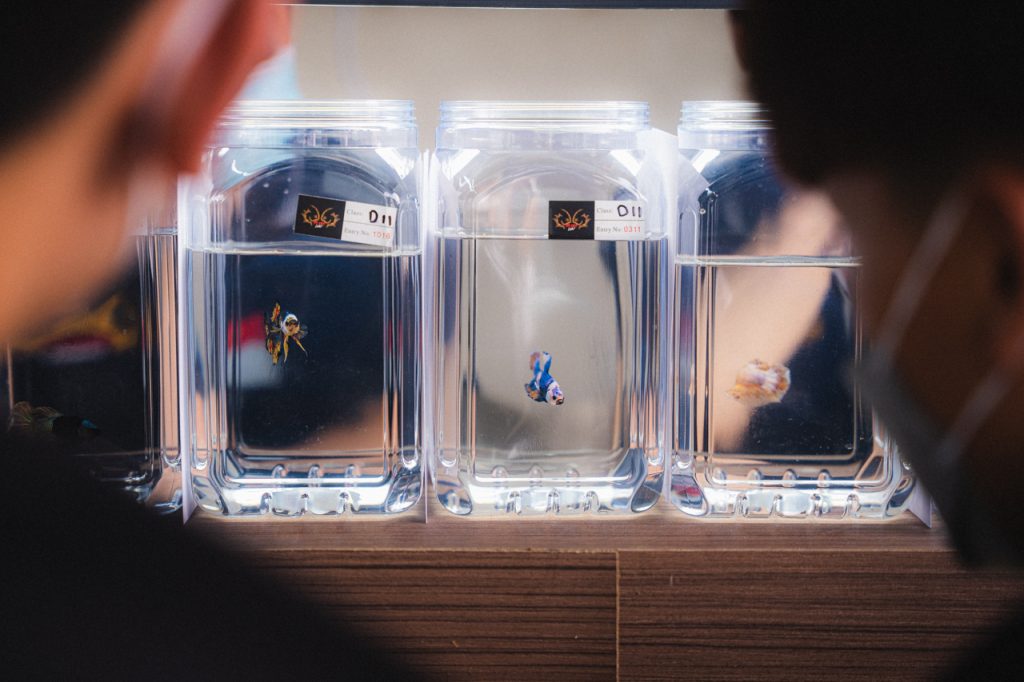
How To Win A Betta Fish Competition
Thrilled to meet the beauty contestants in the rows of clear plastic containers, I walk around the compound, stopping to view contestant A8 swimming gracefully in its tank more closely.
A8’s fins are made up of mesmerising brush strokes of red, maroon, peach, lilac, and violet on a tail shaped like a half-moon—just like its namesake.
Curious, I tail after some judges and committee members as they go from one class of Betta fish to another, looking at each entry number to assess things like finnage, form, and colour.
“What is finnage? What do I look at?” I ask Desmond Hon, a committee member. As an office employee in his early 30s who’s only nine months deep into the hobby, he considers himself a newcomer to the community of Betta fish hobbyists.

Armed with an image of a Betta fish on his phone, Desmond gives me the lowdown on judging Betta fish.
“The finnage consists of the dorsal, ventral, caudal, pectoral, and anal fins as well as the body,” he explains. “The judges also look at whether the fish has a spoon head or bullet head. Fishes with a spoon head will lose points.”
Although new to the world of Betta Fish, Desmond’s passion is evident in how he takes his time to explain facets of the hobby to me. Desmond found solace in a pastime borne out of the pandemic. It opened him up to new experiences when the world seemed so closed off.
“When I was younger, I had never been to fish shops, and I also didn’t know how to take care of fish then,” Desmond shared.
“It’s only when I started taking the hobby more seriously that I realised there’s so much to learn. It’s down to the basics like water, filtration, lighting, and temperature because different types of fish require different conditions to keep them well.”
Beauty Is In The Eye of The Betta Beholder
Eager to put theory into practice, I stroll around the aisles of tanks to see if I can differentiate between a spoon head and a bullet head.

Darwin tells me that the spoon head is a result of inbreeding. Inbreeding for the first few rounds is alright if the purpose is to enhance the finnage and colour. But if done excessively, it would result in a higher rate of deformities, like crooked, short bodies or spoon heads.
I ask if these fish would have difficulties moving around.
He replies matter-of-factly. “No, they won’t suffer or anything like that. But if their traits are not desirable, some breeders would usually feed them to bigger fish or release them into ponds.”
Darwin then points to a female betta to describe what ‘form’ means.
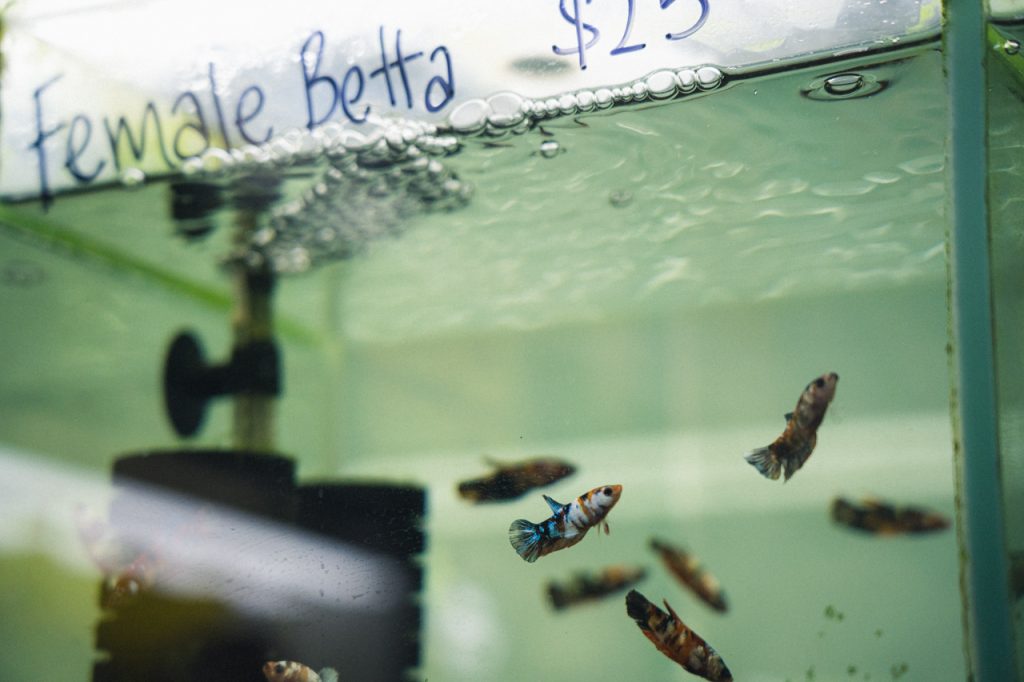
“You can see here that the size of the dorsal, anal, and caudal fins must be proportional to the body size. Some fish have skinny bodies with large finnages, which is not ideal.”
Reminded of my serendipitous encounter with Half Moon, I ask him if this is true—that the more colourful a fish is, the more ideal it stands as a contestant.
“It depends on the classes,” Darwin shares. He explained that in the case of solid classes, like Super Red, Black or Yellow, it is crucial to determine how pure they are in terms of colour intensity.
Darwin cites an example of how some Super Reds may have specks of black or iridescence on their fins. This quality, he tells me, reduces the intensity, and may result in a lower score.
As if on cue, amid our conversation, Desmond and several other judges come over with four plastic containers.
“You can see here that they are all four Super Reds,” Desmond points out. “To the untrained enthusiast, you would think that they are all the same. But if you were to look carefully, they each have individual differences. It takes a keen eye for detail to spot them.”

The People of the Betta Fish Community
For 21-year-old Jordan Tan, his love for rearing Betta fish started back when he was in Secondary 3. He’s here today to help with some light administrative duties, jotting down the final placings of the contestants after the judging is done.
When speaking to Jordan about this hobby, it sometimes feels like his passion borders on obsession. It’s something many hobbyists here, I’m sure, would readily admit.
Smiling, he confesses that he has several tanks at home. (The number actually stands somewhere around 80). As with any serious hobbyist, Jordan also takes part in his fair share of Betta fish competitions.
His secret to the vibrant and colourful bettas he brings to shows lies with dried ketapang leaves (also known as Indian almond tree leaves) that contain tannin. The leaves have various positive effects on the Betta fish; they help to promote a natural habitat for bettas, give colouration to the water, and contain nutrients that enhance the fin health of the fish.
Grinning, Jordan shares that he recently emerged as Grand Champion at a competition held at Macpherson last month.
“So what will you do with the money you have won?” I asked.
“Buy more fish,” he says without skipping a beat.

Equally passionate about Betta fish is 43-year-old Farah Jamal, who used to breed hundreds of Betta fish at home. Now it’s down to a respectable (and more manageable) 30.
“Designer bags? No, I spend on designer bettas,” giggles Farah Jamal, whose interest came after scrolling through betta pictures and videos while working from home during the pandemic.
She dedicates time to cultivating live organisms, like water fleas, baby brine shrimps, tubifex worms and fairy shrimps, so that her fish would obtain the high-protein nutrition they need.
Finding Love In a Fishy Place
Farah shows me a picture of her trophy from a competition held in Penang earlier in June and an impressive setup of her fish tanks.
Like Jordan, Farah regularly sends her fish for competitions to refine her rearing techniques. The competitions allow her to know if there are improvements to be made in terms of increasing their size, enhancing their colour or developing stronger fins.
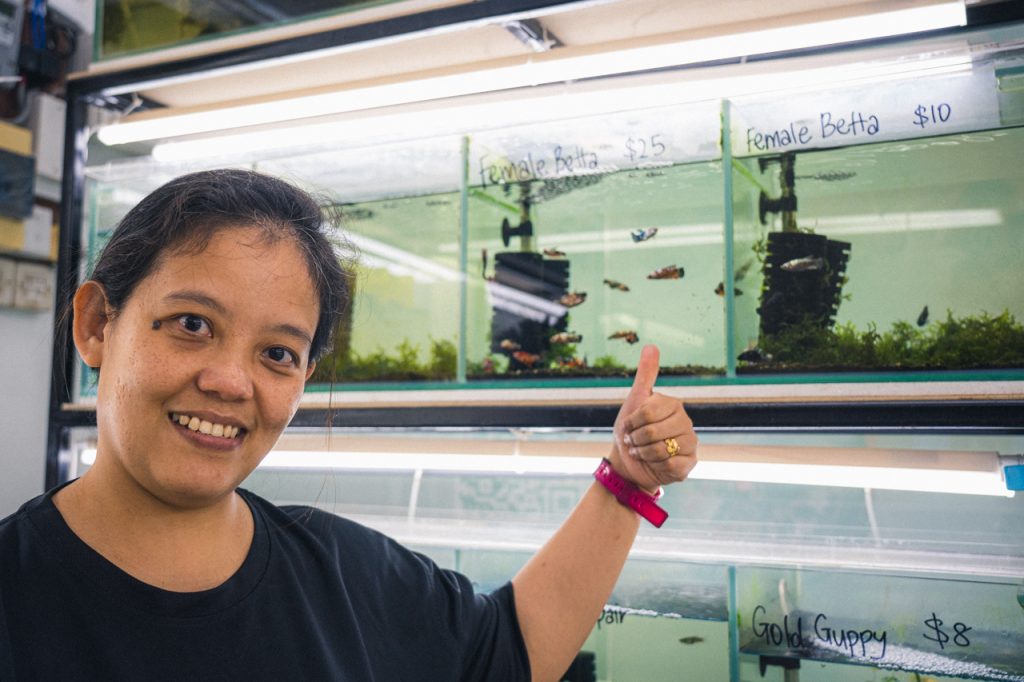
“When I was little, I used to keep a Betta fish in a Nescafe glass bottle,” Farah recalls. “Back then, they did not have as wide varieties as you see today—now there are so many new colours and variations.”
And while Betta fish competitions are quite the singular endeavour, Farah has somehow managed to find love amongst the sea of transparent tanks.
Indeed, it’s no fish tale—Farah met her betta half during one of the competitions.
“Sharing the same interest is a huge plus point in our lives. He has also taught me a lot about betta rearing and competitions. At least he won’t kick my ass if I have a rack full of tanks,” she laughs.
For Jordan, his formative years as a teenager were shaped mainly by his interactions with equally passionate peers he met at neighbourhood fish shops.
It has been close to seven years since he began, and the circle of friends gained from the local Betta fish community has remained the same—only tighter.
He gestures at Darwin, “I have known Darwin since I started rearing Betta fish six years ago. If he needs help at events, I will come whenever I can.”
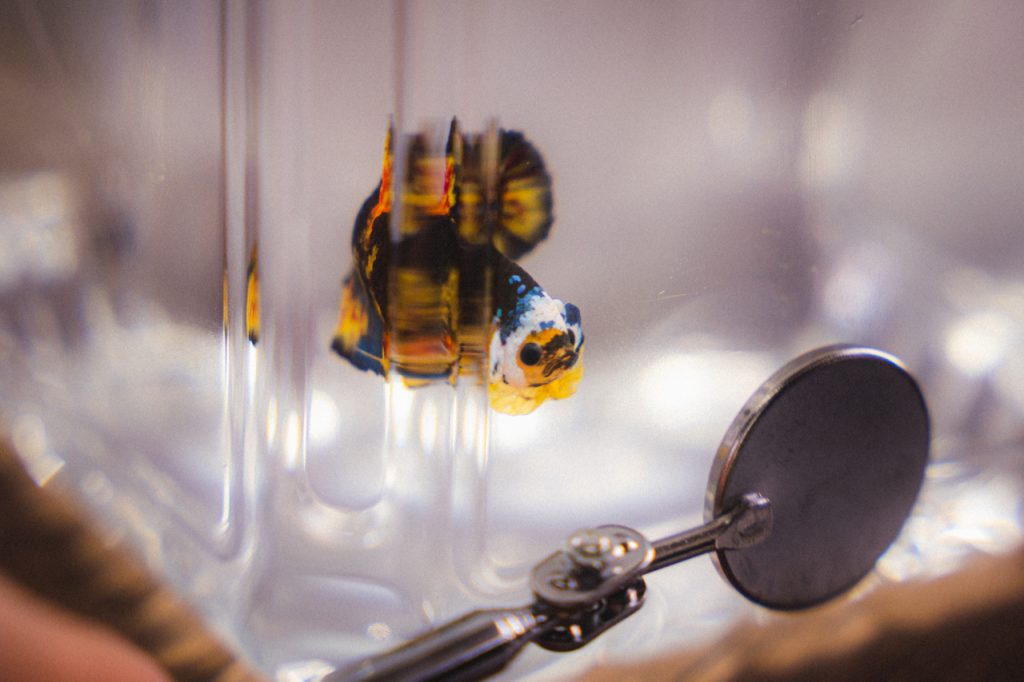
The Debate on Ethics
As with other leisure hobbies involving animals (the songbird comes to mind), the debate on ethics will crop up. It’s no different with the Betta fish community, plagued with the ethical implications of Betta fish competitions, mainly when the fish are triggered to flare.
Using mirrors and flare sticks to induce a feeling of threat, the fish would display their fins for a long time, which many animal activists believe would result in significant stress.
“Flaring is actually like a form of exercise, which improves a fish’s health,” explains 29-year-old Edmund Lee, owner of Edmund Aquatics, an aquarium shop nestled in the neighbourhood of Bedok.
“It encourages them to be active, which helps soothe their digestive system. Fishes that do not flare regularly will suffer digestive problems.”

For Edmund, being ethical in this business means being honest. He’s encountered cases when the fish he bought from sellers completely differed from what he ordered. “That is cheating customers of their money,” he asserts.
I ask if he has encountered cases of negligence from suppliers as a licensed pet shop owner.
“In the past few years, all my fishes have arrived in good condition except for some occasions when they fell sick due to the temperature fluctuations on the plane.”
Edmund tells me that the fish are usually packed in small bags when they journey from their breeding grounds and into the tanks at home.
Longfin Betta fish are sometimes slightly sedated to protect them from harm because they may injure their fins when experiencing stress.
Community—Not Competition
“What do you usually do when your fish dies?” I ask Desmond.
“As they grow older, they will become fatigued and lethargic,” he explains.
“You will see them languishing at the bottom of the tank. I usually bury them. Some would feed them to bigger fish, like arowanas. Others flush them down the toilet bowl. It depends on how much you love your fish—your attachment style.”

Attachment style? To fish? That was certainly something I didn’t expect to hear at a Betta fish competition—a term most people associate more closely with a pet dog or cat.
Still, if my conversations with the judges and spectators at the competition are any indication, the heart of the hobby is community—not competition.
For a newcomer like Desmond, the sense of community is a key part of his sustained interest. “They are always willing to share nuggets of knowledge I never knew about, especially with newcomers like me who tend to experience many failures when rearing fish at the start.”
Perhaps therein lies the secret to keeping any niche hobby alive: support. While embarking on a hobby alone is great for the soul (really, try it), finding like-minded folks with whom you can banter needlessly in jargon gives you something even more precious—a sense of purpose.
Humans need people, and although technology is there to keep us communicating with others, we have become more disassociated. There’s none of that dissociation here today as the motley crew of five jostles about and gamely poses for a group shot. Perhaps these Betta fish hobbyists have got something right all along.

